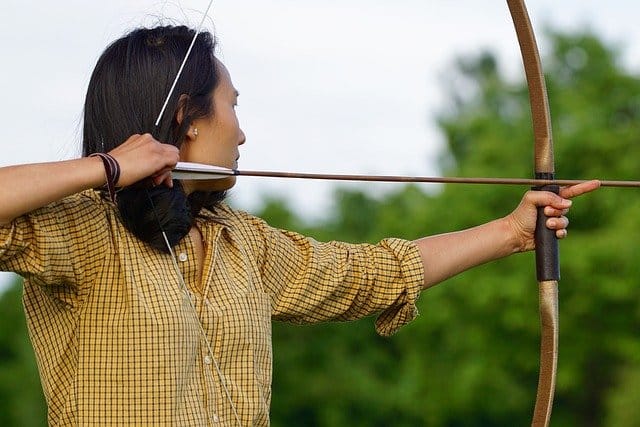Archery is a precision sport that requires immense focus and skill. One of the unique aspects of archery is its specialized scoring system. Scores are calculated based on where arrows land on the target. Understanding how archery scoring works is key to following the sport.
This article will explain the archery points system and how scores are tabulated in competition. Whether you’re an aspiring archer or a spectator, this guide will help you understand the nuances of archery scoring.
Overview of Archery Targets and Scoring
Archery uses colorful circular targets with concentric rings denoting different point values. The inner rings denote higher point values, rewarding accuracy. The outer rings score lower points. Here is a quick overview:
- Bullseye (inner yellow circle): 10 points
- Bullseye (outer yellow circle): 9 points
- Inner red ring: 8 points
- Outer red ring: 7 points
- Inner blue ring: 6 points
- Outer blue ring: 5 points
- Inner black ring: 4 points
- Outer black ring: 3 points
- Inner white ring: 2 points
- Outer white ring: 1 points
- Outside white ring: 0 points
- Completely missing target: 0 points
Arrows must stick in the target to receive a score. The archer’s score is calculated by adding up the values of where each arrow lands. Olympic-style archery uses a 10-point system while other competitions may use an 8 or 9-point system.
Scoring an Archery End
Competitive archery involves shooting multiple arrows in groups called “ends”. In Olympic archery, each end consists of six arrows per archer. Here is how scoring works over an end:
- Each archer shoots six arrows, three at a time.
- After all arrows are shot, they are scored and pulled from the target.
- An archer’s end score is the sum of all six arrow values.
- The maximum possible score for one end is 60 (six bullseyes worth 10 points each).
For example, if an archer’s six arrows scored 10, 9, 8, 7, 6, and 5 points, their end score would be 10 + 9 + 8 + 7 + 6 + 5 = 45 points.
Calculating Total Scores
An archery competition round consists of multiple ends. The archer’s total score is simply the sum of all end scores. So if an archer scored 43, 45, and 50 in three ends, their total score would be 43 + 45 + 50 = 138 points.
The maximum possible score varies based on how many ends are in the round and whether 6 or 3 arrows are shot per end. For instance, a 12-end Olympic round with 6 arrows per end would have a maximum possible score of 12 * 60 = 720 points.
Special Scoring Considerations
There are a few special scoring considerations in competitive archery:
- Tie scores: If two archers tie with the exact same score, the one with more hits closer to center (10s and 9s) wins.
- Bounce-outs: Arrows that bounce off the target are given the score of where they impacted before bouncing.
- Pass-throughs: Arrows that pass all the way through the target are awarded the score of where the hole lies.
- Equipment failures: Arrows lost due to unexpected equipment issues are re-shot without being scored.
Why Accuracy Matters
Accuracy is paramount in archery. Even small differences in arrow placement make big impacts on scores. For example:
- An arrow just outside the bullseye ring scores 8-9 points.
- An arrow just inside the bullseye ring scores 9-10 points.
That seemingly minimal difference could change an archer’s end score by 6+ points and their overall score by dozens of points.
Top archers are able to repeatedly hit the center rings. This precision shotmaking separates the best from the rest.
Archery Scoring in Competition
Official scorers tabulate archery scores in competition. Arrows are assigned values after each end. Running scores are maintained as the round progresses.
Scoring transparency and accuracy are crucial. Scorers closely inspect arrow impacts. Judges may be called to help determine ambiguous arrow values.
At high levels of competition, there are safeguards like having multiple independent scorers compare notes. This ensures the archers receive fair, accurate scores.
Training to Improve Scoring
For archers, consistently high scores require immense skill and practice. Here are some ways archers train to achieve better scores:
- Use a sight-in range to dial in their aim and equipment.
- Shoot multiple practice ends per day to groove form and repeatability.
- Treat practice like competition, scoring each end and not just mindlessly shooting.
- Evaluate groupings and trend lines to identify patterns needing improvement.
- Use video review to analyze form and release for ways to improve shot execution.
- Perform strength training to build stamina and prevent fatigue as competition rounds wear on.
- Work extensively on proper breathing, release, and follow-through techniques.
With dedicated training and analysis, archers can gain the marksman-like accuracy needed to score well in competition.
Final Thoughts on Archery Scoring
While not too complex, once you understand the colored target rings and points per arrow, archery scoring is straightforward to follow. The archer with the highest cumulative points across all ends wins the match. Trained eyes and mental precision are needed for archers to hit the highest-scoring target areas consistently.
Next time you watch archery, keep this scoring guide in mind. Use it to gain a deeper appreciation of the skill and focus required to excel at this demanding sport. Whether in backyards or the Olympics, understanding archery scoring enhances enjoyment as a spectator or judge.


